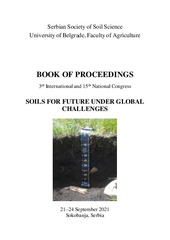Приказ основних података о документу
Land use Effects on Soil Pore-Size Distribution and Soil Water Retention
| dc.creator | Gajić, Boško | |
| dc.creator | Kresović, Branka | |
| dc.creator | Tolimir, Miodrag | |
| dc.creator | Životić, Ljubomir | |
| dc.creator | Lipovac, Aleksa | |
| dc.creator | Sredojević, Zorica | |
| dc.creator | Gajić, Katarina | |
| dc.date.accessioned | 2024-01-09T13:27:39Z | |
| dc.date.available | 2024-01-09T13:27:39Z | |
| dc.date.issued | 2021 | |
| dc.identifier.isbn | 978-86-912877-5-7 | |
| dc.identifier.uri | http://aspace.agrif.bg.ac.rs/handle/123456789/6730 | |
| dc.description.abstract | Soil pore characteristics can have great impact on plant growt and environment. A study was conducted to evaluate the efects of different land use on porosity, pore size distribution (PSD) and soil water retention (SWR) of Fluvic Phaeozem in the Kolubara River valley, Serbia. The land use treatments included: natural forest, native meadow, and arable land managed in the same way for more than 100 years. Disturbed and intact soil samples were collected from three soil profiles at each of the three different land use types from depths of 0–15, 15–30 and 30–45 cm. The capillary rise equation was used to estimate effective pore sizes from water retention measurements. Pressure cells are used to mesure water retention in the water potential range from –33 to –1500 kPa. The bulk density (BD) was significantly (P < 0.05) larger for meadow (1.48–1.49 g cm–3) and arable land (1.28–1.42 g cm–3) than forest (0.99–1.29 g cm–3) at the top 30 cm of soil. There was no significant difference in BD between meadow and arable land in the subsurface soil layer (15–30 cm). Depending upon the increases in BD and disruption of pores by mowing and tillage management, total porosity decreased accordingly in meadow and arable land. Land use had significant effect on PSD. Volume of macropores (> 30 μm) were significantly higher for forest (10.93–16.19%) than meadow (4.77–5.74%) and arable (4.83–7.81%) land for 0–30 cm soil layer. Among the diferent land use types, forest and arable land had significantly higher mesopores (30–3 μm) volume compared with meadow. Mowing and tillage management significantly decreased volume of micropores < 3 μm diameter size at the 0–30 cm soil depth. The results showed that in the 0–0.15 m and 0.15–0.30 m depth soil layers, forest soils showed a significantly higher the available water capacity compared to meadow and arable lands. The S-index also detected clear differences among land uses. In this study, the soil water retention data are well described by the van Genuchten model. In conclusion, our results showed that total porosity, PSD, and moisture retention significantly changed because of the different management systems in the top 30 cm of soil, which can potentially influence crop yields and ecosystem function | sr |
| dc.language.iso | en | sr |
| dc.publisher | Serbian Society of Soil Science | sr |
| dc.relation | info:eu-repo/grantAgreement/MESTD/inst-2020/200116/RS// | sr |
| dc.rights | openAccess | sr |
| dc.rights.uri | https://creativecommons.org/licenses/by/4.0/ | |
| dc.source | 3rd International and 15th National Congress of Serbian Society of Soil Science: Soils for Future under Global Challenges, Sokobanja, Serbia, 21-24 September 2021, Book of Proceedings | sr |
| dc.subject | land use change | sr |
| dc.subject | Fluvic Phaeozem | sr |
| dc.subject | bulk density | sr |
| dc.subject | soil porosity | sr |
| dc.subject | water retention curve | sr |
| dc.subject | S-index | sr |
| dc.title | Land use Effects on Soil Pore-Size Distribution and Soil Water Retention | sr |
| dc.type | conferenceObject | sr |
| dc.rights.license | BY | sr |
| dc.citation.epage | 328 | |
| dc.citation.spage | 313 | |
| dc.identifier.fulltext | http://aspace.agrif.bg.ac.rs/bitstream/id/25641/bitstream_25641.pdf | |
| dc.identifier.rcub | https://hdl.handle.net/21.15107/rcub_agrospace_6730 | |
| dc.type.version | publishedVersion | sr |


